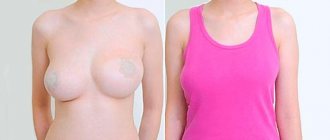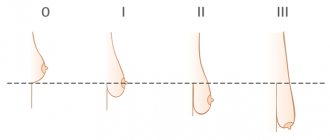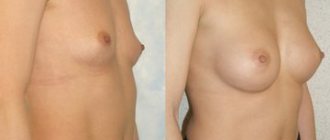Not only the beauty of her breasts, but also her ability to feed a newborn baby will depend on the natural anatomy of a woman’s nipples. Each representative of the fairer sex has a breast that has its own special attractiveness; there are differences not only in size, but also in relation to the shape and color of the nipples. Such differences are normal and should not bother a woman, since such breast characteristics depend on genetics, race, and some other indicators.
Nipple structure
If we consider the structure of the nipple, it is formed in the form of a protrusion above the mammary gland. It is an accumulation of skin, and it is especially delicate and sensitive due to the accumulation of receptors, as well as close contact with nerve endings, including the intercostal system.
The anatomy of the nipples suggests a relationship with halos, which may have a darker shade. On the surface of the areola there are small tubercles, which are sources of secretion of special compounds that prevent drying out and damage to the nipples. Their functions are especially important during breastfeeding.
List of reasons why nipples become hard in women3
- Stress. Yes, breasts are also susceptible to changes in the life of their owner. If a girl is in constant tension for a long time, then the result is obvious - the nipples become hard on their own. This is because there are a lot of nerve endings in the chest that are responsible for this reaction.
- Hormones. Small changes in hormonal terms cannot do without physiological changes. If your hormones are out of whack, you may notice how often your nipples become hard.
- Excitation. This is the most proven way to test your nipples for receptivity. With strong arousal, almost everyone can see how literally before their eyes the nipples turn into protruding tubercles.
- Disease. An increase in body temperature also causes nipples to harden. If, when you have a cold, you suddenly notice how your nipples become tense, do not be alarmed, this is natural.
- Pregnancy. An interesting position is a guaranteed cause of hard nipples. During this period, the breasts become more receptive to any touch and are very often in an excited state.
But you should not think that this function of the body is entirely a female prerogative. Men can also boast of this reaction in some cases:
- At puberty. At this point, boys gradually turn into real guys, so it is not surprising that their entire body reacts sharply to these changes.
- When intoxicated. When taking a dose of strong drinks, a man should be prepared for the fact that his nipples may harden.
- Sexual desire. The stronger sex also feels how hard the nipples become when aroused. Although this phenomenon is not observed in all guys.
Nipples are an integral part of the human body. Women's nipples are of interest, they are attractive and become the subject of sexual fantasies. Men's are just a necessary element to make the body look natural. In addition, this organ can become a tool for the sweetest orgasms, because many people are very sensitive, so they experience pleasure from breast stimulation.
Nipple color and what it depends on
The skin tone of the nipples and adjacent areola can be different, since each organism has its own certain amount of hormones responsible for skin color and pigmentation. That is why the color of the nipples can change over time, for example, in girls they are often light pink, during puberty they darken a little, and during pregnancy the shade can change in any direction, although darkening of the tissue is more often observed.
The fundamental factor in the color of the outer part of the mammary gland is race, genetic predisposition, and hormonal background.
Changes
All changes in the female breast are directly related to changes in hormonal levels.
Puberty
Before the onset of puberty, the mammary glands consist of a small number of lobes, connective and fatty tissue, and are in an underdeveloped state. During puberty, branching and growth of the milk ducts occurs, as well as the proliferation of adipose tissue.
Birth of a child
Intensive growth of glandular tissue with branching and elongation of ducts, development of alveoli, production and accumulation of milk in them, intensive growth of glandular tissue lead to a significant increase in the bust during pregnancy and lactation.
After breastfeeding ends, breast size decreases due to a reduction in secretory sections. When the next pregnancy occurs, the entire cycle repeats again.
Menopause
During menopause, the reverse development of the mammary glands begins - senile involution. The body of the gland disappears, and only connective fibers and adipose tissue remain.
The shape of the nipples and what it depends on
The normal anatomy of the nipples suggests differences in the shape and size of the protrusions themselves, and this should not bother a woman, since each woman’s breasts have individual characteristics. If we classify nipples by shape, we can distinguish the following types:
1. Convex or protruding. They protrude significantly above the breasts; some women experience discomfort, since the nipples stand out especially under clothing; 2. Normal. The conditional norm is considered to be an average elevation above the surrounding tissues; a natural increase occurs with changes in temperature and emotional arousal; 3. Flat. According to some reports, flat nipples are more common in women. They are almost at the same level with the areola, but under certain influences that affect sensitivity, they rise slightly 4. Retracted. If retraction develops from birth, then during puberty or after childbirth a change in shape is possible, since the anatomy of the nipples suggests some age-related changes. During the breastfeeding period, a specialist may be required to establish lactation and help the baby adapt to the mother’s breast. In case of sudden changes in the breast, you should contact mammology for diagnostic measures. 5. Versatile. Nature allows some asymmetry and it may affect the nipples. This is not considered an abnormality, but sometimes requires observation, especially if there are strong differences, for example, one nipple is inverted and the other is protruding.
In addition to the shaped difference, there are several options for the direction of the nipples. They can be straight, have opposite lines, or point down, which is more common in women over 40 years old. These indicators vary for every woman, especially for those who have given birth and nursed their babies for a long time. For the anatomy of the nipples, changing direction is natural, but there are some techniques that help support the skin, for example, proper attachment of the baby when feeding, care, massage, special underwear, and so on. The shapes and sizes of the outer part of the breast may differ from generally accepted standards presented in the modeling business and other fields. Only this fact should not become the reason for surgical intervention, since the specialist can also propose other programs to change the size and shape of the nipples, if this is really necessary.
Internal structure of the female breast
Regardless of the shape and size of the mammary gland in women, the structure of the organ is the same for all representatives of the fair sex. It consists of 15–20 lobes, which are formed by dividing the glandular connective tissue. Each lobe is divided into smaller segments. The space between the lobules is filled with adipose tissue. An accumulation of fatty tissue is present at the base of the gland. It creates a “cushion” on which the glandular tissue itself is located. The volume and size of the breast depend on the amount of fatty tissue.
Glandular tissue consists of small glands that are localized in lobules. Each of the glands consists of many branching tubes, at the end of which there are small extensions - small vesicles, alveoli. They are the secretory component of the glands where milk is produced. The glands are connected to each other by small tubes - excretory ducts. The terminal sections of these structures, the milk ducts, gradually transform into the milk sinuses, which open on the nipple. As can be seen from the above, the internal structure of the mammary gland has a complex, unique structure.
The structure of the mammary gland lobule
The anatomy of the female breast is very complex. Each lobe of glandular tissue consists of many lobules from which the milk ducts emerge. These terminal ducts merge with each other into large lobar formations. Each lobe has the shape of a cone, the apex of which is located in the nipple area. In the areolar region, the duct expands, forming the lacteal sinuses.
Types of breast structure
The first qualitative classification of mammographic density types was described in 1976 by Wolfe. He divided the obtained mammograms into 4 types of structure, taking into account the predominance of adipose and glandular tissue, each of which corresponds to its own type of mammary gland structure according to ACR:
- The type of structure of the mammary glands is N1
- the gland consists predominantly of adipose tissue, which corresponds to ACR1 (the risk of cancer is low, Fig. a). - P1
– adipose tissue and linear densities (dilated ducts) occupy up to 25% of the gland’s volume. ACR2 compliant (low cancer risk, figure b). - P2
- dilated ducts make up more than 25% of the volume, localized in the upper outer quadrant of the chest. This type corresponds to ACR3 - high risk of breast cancer (Fig. c). - DY
– breast with dense structure, corresponding to ACR4 – maximum risk of cancer (Fig. d).
Functions of the nipple
More often, breasts are one of the attractive parts of a woman’s body, but, nevertheless, its main function, inherent in nature, is feeding offspring. Milk flows through the nipples, passing through the ducts and previously formed and accumulated in the alveoli.
The anatomy of the nipple means that this part of the breast is highly sensitive. It has many receptors, nerve endings and the finest tissues. If we consider the additional functions of the outer part of the chest, its features, we can highlight:
• Additional sexual stimulation, and touching can bring pleasure to both partners; • Changes in shape can signal temperature changes in the body. When there is cold or chills, the nipples harden and change shape; • The hormonal state of a woman is reflected in the configuration and color of the nipple, and this can become a signal for additional examination; • An attribute of attractiveness, which for some is one of the most important in a woman’s appearance.
The characteristics of the breast largely depend on physiological, age and genetic characteristics, so each lady finds her own functions for her.
What factors influence breast growth?
Bust volume depends on a number of objective indicators:
- hormonal stability;
- total mass of a person;
- heredity;
- body constitution.
For normal growth of a woman's breasts, hormonal balance is necessary. The body of any representative of the fairer sex produces four types of sex hormones. The ovaries produce estrogen.
Its maximum concentration accumulates by the time menstruation begins; during this period, the body tries to make reserves of subcutaneous fat. Estrogen paired with progesterone is responsible for the functioning of the reproductive system.
When the first menstruation begins or pregnancy develops, prolactin is actively produced.
They and estrogen are responsible for breast formation. The female pituitary gland produces somatotropin. This compound affects all functions of the body, including the growth of the paired organ.
By about 30 years of age, its production decreases noticeably, so it is necessary to take somatotropin for breast growth after this period.
It has been noticed that thin girls have a barely noticeable bust. This fact is easy to explain: the reason for everything is too little adipose tissue.
She is the one responsible for the volume. A lack of nutrients, vitamins and minerals in a woman’s diet leads to underdevelopment of the mammary glands.
Lack of physical activity provokes atrophy of the pectoral muscles. This phenomenon can also explain why breasts do not grow.
Heredity
Inherited body type plays a big role. Bust size is formed due to two factors: natural data and the principle of fat accumulation, taking into account the constitution of the body.
Female physiology distinguishes several types of figures. It has been noticed that if a girl has narrow shoulders and chest, a thin waist, but at the same time large hips, her breasts will be small. This is due to the fact that fat accumulation with such a physique occurs preferentially on the buttocks.
If a girl’s figure develops and becomes similar to an isosceles triangle (broad shoulders, waist and narrow pelvis), she can count on a large breast volume. With this constitution, fat is deposited mainly in the upper part of the body.
General data and interesting information
In their desire to acquire ideal, by generally accepted standards, breasts, some women make irreparable mistakes. To avoid such troubles, you should have a superficial understanding of the anatomy of the nipples and adhere to the following recommendations:
1. Correctly selected underwear is a good prevention of sagging breasts and changes in the direction of the nipples; 2. Surgical correction of the soft tissues of the glands involves changing the protruding parts, otherwise proportionality is lost, for example, a large breast and a small nipple; 3. Small nipples are not an obstacle or serious difficulty in breastfeeding, nor are inverted or large nipples. The situation can be corrected by attachments and specialist consultations; 4. It is necessary to select appropriate cosmetics specifically for nipples and not only during lactation. This will help prevent dryness and cracks, which will only have a positive effect on the condition of the skin; 5. There are temporary changes in the nipples that occur due to hormones. This may be the appearance of hair, tubercles, darkening, or increase in size. There is no need to be afraid of such phenomena, they are often caused by natural restructuring of the body, but contacting a mammologist will be useful.
Every woman should not only worry about the attractiveness of her breasts, including the shape, color, and size of the nipples, but also take care of the health of the mammary glands. This also applies to a meaningful attitude towards surgical interventions, the feasibility of which should always be discussed with a specialist.
Mammary glands: abnormalities
In the development of the mammary glands, disruptions often occur, mainly due to changes in hormonal levels, against the background of which such anomalies arise as:
The so-called pathological enlargement of the breasts to gigantic sizes, when a woman not only cannot see her even outstretched legs, but also moves around the house with difficulty, and any household chores are difficult for her. This pathology can be combated through breast reduction surgery. However, in real life, such ladies are in high demand and are in no hurry to reduce their bust: they are included in the Guinness Book of Records and actively participate in various photo shoots. So, the anomaly turned into a great way to make money;
A less common disease is polymastia, which is the formation of additional mammary glands. This pathology occurs even during the intrauterine development of the fetus, when some malfunction occurs in the body. Oncologists strongly advise removing “extra” breasts so that the pathology does not lead to the development of oncology;
Continuing the topic: the internal and external structure of the female breast: norm and deviations, we need to dwell on one more anomaly - polythelia, this is the formation of additional nipples on the body. They can be of different sizes, surgeons also advise removing them so that the patient does not experience discomfort and a feeling of inferiority;
Amastia is perhaps the rarest and most depressing pathology - this is the complete absence of breasts and even nipples, it happens in both women and men, that is, outwardly it looks like a “flat front with ribs” covered with skin. Such an anomaly has a negative effect on the mental state and makes it impossible for women to feed the baby; it does not cause any other inconvenience or painful sensations.
Using nursing pads
An inverted papilla (natural causes in women are not a reason to refuse breastfeeding) during lactation can be corrected by using specialized overlays. They can be made of latex or silicone (the latter is preferred due to ease of use and durability).
The soft material fits snugly to the mother's breast and completely follows the natural shape of the nipple. Holes in the device (near the nipple and along the edges) allow milk to be released in doses during sucking, and also allow the baby to smell the mother’s smell.
Recommended pads:
| Company name | Device characteristics | Average price (in rubles) |
| AVENT | The pad is made of silicone. The device enhances lactation and reduces discomfort and pain during feeding. | 1100 |
| NUC | Triangular shaped silicone pads. Available in 2 sizes. When used, it stimulates milk production. | 400 |
| Philips Avent | Made from ultra-thin silicone. It has no foreign odors and does not distort the taste of milk. When feeding, stimulates lactation. | 650 |
| Contact | The pads are made of silicone. Convenient for gripping when feeding (for a newborn). They relieve pain in the presence of cracks and prevent injury to the nipple during teething in a child. | 600 |
When choosing a device, it is recommended to obtain a preliminary consultation with a pediatrician.
What can't you do?
If there is an inverted nipple, a woman should initially undergo a full diagnosis and identify the cause of the deviation. If retraction is a symptom of the development of pathology, then various methods (massages, pads, vacuum devices) will provoke the development of complications from manipulation.
Also, after eliminating the cause, the shape of the nipple can return to its natural shape on its own. All methods of nipple traction are not recommended for use before the age of 18. Before this age, the glands are still developing, and procedures can disrupt the formation and development of the glands.
A retracted papilla is not only a psychological discomfort, but also causes difficulties during the lactation process. To confirm the pathology, you can initially perform a self-diagnosis to determine the degree of nipple retraction.
The final diagnosis, identifying the cause and method of treatment, is determined by the doctor. Manual methods, onlays or surgical treatment are used to eliminate pathology in women.
Author: Kotlyachkova Svetlana








